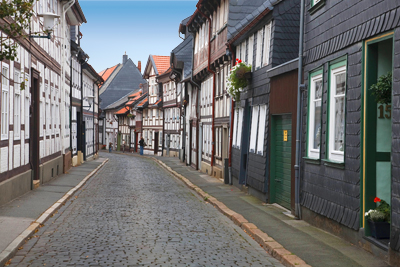Is it accurate to call gose, a salty, 1,000-year-old German wheat ale, mainstream? The answer from Brewmaster Brian Edmunds at Breakside Brewing in Portland, OR, is decidedly yes. “We actually do—or have done—a number of different ‘Old World’ styles at different points,” he says.

Goslar, a historic district in Lower Saxony, Germany, is not only known for its half-timbered houses, but also for gose, first brewed there a thousand years ago.
Which is understating things somewhat. In addition to brewing an impressive four varieties of gose, Breakside also has released a grätzer, a Devonshire white ale, a Dortmunder Adambier, a Franconian kellerbier and a Belgian grisette. Not bad for a business that not long ago celebrated its second anniversary.
As the number of craft breweries has steadily increased, some newcomers have sought to define themselves by expanding beer’s playbook. True, small brewhouses limit capacity, but they also allow for experimentation. Besides that, not everyone is eager to compete for a slice of the coveted—and crowded—India pale ale market. So, in an effort to distinguish their brands, or in some cases simply test to their brewing prowess, enterprising businesses such as Breakside are branching out by rolling back the clock.
German Gose
Owing its name to the Gose River in Lower Saxony, gose is thought to have originated in the 10th century, possibly earlier. Located in a region known for its mineral wealth, the breweries in the town of Goslar likely developed their uniquely local beer with the help of a salty water supply. The grain bill consisted of wheat and barley malt in roughly equal proportions, with the scale usually tipping toward wheat. Spicy coriander commonly overshadowed a mild hop profile, and fermentation was spontaneous. The style’s popularity surged in the 18th century, when brewers in nearby Leipzig took to gose, but World War II and then the Cold War nearly doomed it to the history books. In Germany, Brauhaus Goslar, Bayerischer Bahnhof and Ritterguts Gose GmbH still produce this pale, medium-bodied and slightly sour ale, but until a few years ago, it wasn’t a beer anyone was likely to stumble across in the United States.
Edmunds isn’t the only gose revivalist, and Breakside is far from the only brewery tinkering with historic recipes. In Mount Pleasant, S.C., Edward Westbrook of Westbrook Brewing made a Lichtenhainer, a grätzer and a gose this year, inspired in part by Stan Hieronymus’ Brewing with Wheat. Instead of adding lactobacillus to achieve the desired sourness in both the Lichtenhainer and the gose, however, Westbrook relied on sour wort instead.
Edmunds, on the other hand, began by tasting Bayerischer Bahnhof Leipziger Gose. Starting with a traditional interpretation of the old beer, he initially used Weyermann malts, green coriander from a local farm and fleur de sel to produce a bright, aromatic final product. But he didn’t stop there.
“We’ve riffed on the gose style in more progressive ways by making a version with salt plums and another with lemongrass, tomatillo and smoked salt. Also, I prefer using a Belgian yeast strain,” he explains. “I find the softer ester/phenol profile to work really well with the salt and coriander.”









